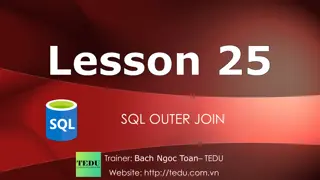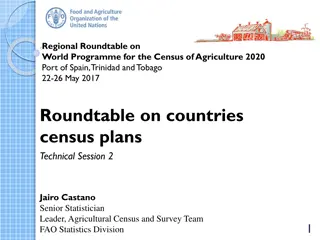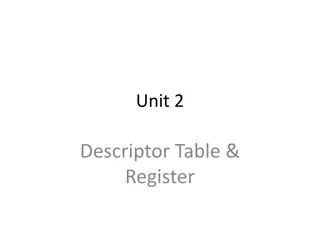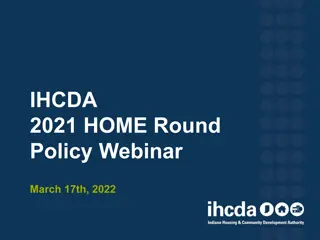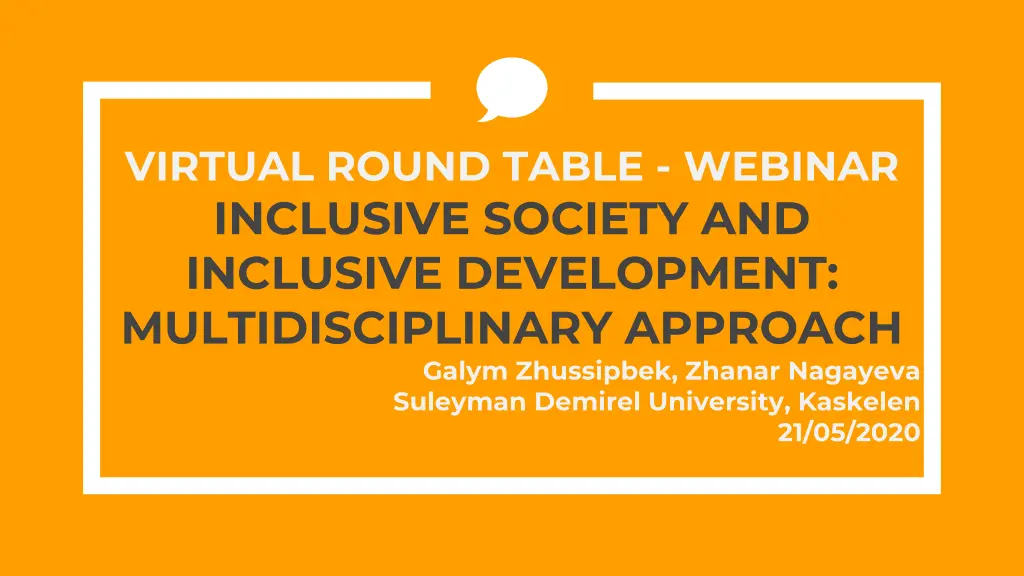
Developing Inclusive Society and Overcoming Obstacles
Explore a multidisciplinary approach towards creating an inclusive society and inclusive development. Uncover obstacles such as racism, hate speech, and structural oppression, and discover strategies to promote inclusiveness through values education, respect for human rights, and the eradication of negative social norms. Learn how to develop children's rights, eliminate tribalism, and foster positive social capital for a more inclusive future.
Download Presentation

Please find below an Image/Link to download the presentation.
The content on the website is provided AS IS for your information and personal use only. It may not be sold, licensed, or shared on other websites without obtaining consent from the author. If you encounter any issues during the download, it is possible that the publisher has removed the file from their server.
You are allowed to download the files provided on this website for personal or commercial use, subject to the condition that they are used lawfully. All files are the property of their respective owners.
The content on the website is provided AS IS for your information and personal use only. It may not be sold, licensed, or shared on other websites without obtaining consent from the author.
E N D
Presentation Transcript
VIRTUAL ROUND TABLE - WEBINAR INCLUSIVE SOCIETY AND INCLUSIVE DEVELOPMENT: MULTIDISCIPLINARY APPROACH Galym Zhussipbek, Zhanar Nagayeva Suleyman Demirel University, Kaskelen 21/05/2020
WANT BIG IMPACT? Obstacles to develop inclusive society/ inclusiveness in society? 2
Obstacles 1.racism (present in our society) 2.hate speech (can be observed in our society) 3. Culture of dominance leading to oppression 4.oppression, structural oppression 5.not valuing a human being 6.not respecting human dignity 7.old perceptions of culture and identity 3
WANT BIG IMPACT? What to do to develop inclusive society/ inclusiveness in society? 4
In general/the main aspects: - to recognize and respect all fundamental and especially absolute rights & and person s integrity - morality is to respect the [human] rights of other people/ not to violate the human rights of other people - to have values education - universal values: the respect for human being, empathy, solidarity and justice - to uphold justice and to have the rule of law - where all norms and laws must respond to the basic human rights principles - the foundational idea of human rights is to respect human dignity/ to respect human only because of one s being a human being - is to cultivate the respect for human being - to provide equal opportunities - to have modern state where the public office cannot be inherited or cannot be occupied because of tribal or familial relations, not patrimonial or neo- patrimonial - to have upgraded culture, not tied to archaic customs and traditions, superstitious beliefs. 5
Specifically to develop children rights to abandon old Prussian- style negative disciplining education system in education system/ adepti bala etc discourses in schools; to get rid of negative social capital and to develop positive social capital; to end tribalism, clannism, nepotism; to reassess culture of dominance in family and social life - to get rid of paternalism; 6
Conservative post- Soviet Child-rearing Discourse We claim that conservative claims about family values in a sense of Strict Parent Model are ideological and not independent, they are based on the continuation of former Soviet-mind set. There is a strong correlation between violent punishment and humiliation of children and political authoritarianism. 7
George Lakoff AUTHORITARIAN OR STRICT PARENT MODEL Acceptance a child as inferior, violation of his rights Set of Standards to shape, control, and evaluate child s behavior Strict discipline, strict rules. Method of Reward and Punishment Obedience, and respect for authority. Preservation of order Discouraging verbal give-and-take between parents and a child AUTHORITATIVE OR NURTURANT PARENT MODEL Acceptance and Respect for a child, his individuality, rights. Justice Rules and standards (no corporal painful and harmful punishment) Encouragement of the child s independence, originality, critical thinking Two-way communication based on respect, exchange of points of view. Parents explain children their decisions Encouragement verbal give-and-take between parents and a child 8
EFFECTS ON A CHILD Authoritarian or Strict Parent Model Law self-esteem, -respect and - confidence Lack of critical thinking, blind obedience Aggressiveness (Legitimacy of violence), Lack of empathy and sociability Lack of conscience, soc. responsibility Necessity for external control Dependence on the moral opinions of others Authoritative or Nurturant Parent Model High self-esteem, -respect, -confidence Critical thinking, questioning, originality Empathy, maintenance of social ties Soc. responsibility (family and community) Self-control Think and act on his own both mentally and socially, Independence, Individuality 9
EFFECTS ON SOCIETY Authoritarian or Strict Parent Model Low degree of rule of law, violations of the rights of women, children. Violation of environmental norms Lack of Innovations, sophist. businesses High level of violence, unlawful activities (bribery), crime Low level of pluralism, respect for others External moral orientation-window- dressing Lack of social movements, NGO, ind. media Disposition for Authoritarianism Authoritative or Nurturant Parent Model Rule of law, Justice and protection of rights of women, children, minorities. Environmental standards High level of Innovation, new technologies Empathy, low level of crime, unlawful activities Pluralism, acceptance of others Ethical behavior, soc. programs Independent media, NGO, pol. parties, etc. Disposition for Democratic culture 10
Baumrinds 4 Parenting Styles are categorized based on two dimensions of parenting behavior: Demandedness refers to the extend parents control their children s behavior or demand their maturity. Responsiveness refers to the degree parents are accepting and sensitive to their children s emotional and developmental needs. 11
Baumrinds 4 Parenting Styles Authoritative Parenting High Demandingness. High Responsivenss Authoritative parents have high expectations for achievement and maturity, but they are also warm and responsive. They set rules and enforce boundaries by having open discussion and using reasoning. They are affectionate and supportive and encourage independence. (known as Democratic Parenting Style) children of authoritative parents are: Appear happy and content, independent, Achieve higher academic success, good selfesteem, Interact with peers using competent social skills, Have better mental health less depression, anxiety, suicide attempts, delinquency, alcohol and drug use, Exhibit less violent tendencies Authoritarian Parenting High Demandedness. Low Reponsiveness Authoritarian parents demand blind obedience using reasons such as because I said so . They use stern discipline and often employ punishment to control children s behavior. They are unresponsive to their children s needs and are generally not nurturing. children of authoritarian parents are: Are less independent. Appear insecure. Possess lower selfesteem. Exhibit more behavioral problems. Perform worse academically. Have poorer social skills. Are more prone to mental issues. Are more likely to have drug use problems. 13
Baumrinds 4 Parenting Styles Permissive Parenting (Indulgent , ) Low Demandedness. High Responsiveness Permissive parents set very few rules and boundaries and they are reluctant to enforce rules. These parents are warm and indulgent but they do not like to say no or disappoint their children children of permissive parents: Cannot follow rules, Have worse selfcontrol, Possess egocentric tendencies, Encounter more problems in relationships and social interactions Neglectful Parenting (Uninvolved) Low Demandedness. Low Responsiveness. Neglectful parents do not set firm boundaries or high standards. They are indifferent to their children s needs and uninvolved in their lives. These uninvolved parents tend to have mental issues themselves such as maternal depression, physical abuse or child neglect when they were kids. children of neglectful parents are: Are more impulsive, Cannot self-regulate emotion, Encounter more delinquency and addictions problems, Have more mental issues e.g. suicidal behavior in adolescents 14
Education We argue that thorough political analysis of authoritarianism should include the question How a dominant education model is constructed? inasmuch education system is shaped by hegemonic (power-holding) groups. Specifically, the dominance of Strict Parent model in childrearing and education has inevitable spillover effects to all aspects of social life. 15
Quality of the education system, score 1-7 Public expenditure on education, % of GDP, 2005-2014 6.8 5.9 5.6 5.3 5.3 Australia 5.2 5.1 5.0 8.0 Kazakhstan Germany 3.1 6.0 4.0 Kyrgyz Republic Canada 2.0 0.0 Tajikistan Netherlands Switzerland United States Finland Health and primary education, rank out of Innovation and sophistication factors 140 (1 is the best) 7.0 6.0 98 Score 1 -7 93 5.0 100 4.0 46 3.0 50 13 11 9 2.0 7 6 1 1.0 0 0.0 The Global Competitiveness Report 2014
Performance of 15-year old students, 2012 Science Mathematics Reading Kazakhstan Switzerland Finland Israel United States Netherlands Canada Germany Australia 0.0 100.0 200.0 300.0 SCORE 400.0 500.0 600.0 59% of students aged 15 are functionally illiterate (UN 2012)
Ethical behavior of firms, score 1-7 Transparency of government policymaking, CA score 1-7 Countries 7.0 6.0 5.0 4.0 Kyrgyz Republic 3.0 2.0 1.0 Switzerland 0.0 United States Canada Australia 0.0 1.0 2.0 3.0 4.0 5.0 6.0 7.0 The Global Competitiveness Report 2014 Irregular payments and bribery, rank out of 140 Organized crime, rank out of 140 CA Countries 140.0 Kazakhstan 120.0 Kyrgyz Republic 100.0 Tajikistan 80.0 Switzerland 60.0 Finland 40.0 United States 20.0 Netherlands 0.0 Canada Germany Australia 0.0 20.0 40.0 60.0 80.0 100.0 120.0 140.0
The highest suicide The highest suicide rate among girls aged rate among girls aged 15 to 19 15 to 19 One third of marriages One third of marriages end with divorces end with divorces SUICIDE RATE SUICIDE RATE - - 10 10 DOMESTIC DOMESTIC VIOLENCE VIOLENCE INNOVATION INNOVATION KAZAKHSTAN KAZAKHSTAN CENTRAL CENTRAL WOMEN WOMEN ASIA ASIA EDUCATION EDUCATION Women s Women s imprisonment has imprisonment has become one of the become one of the leading domestic issues leading domestic issues CHILDREN S CHILDREN S RIGHTS RIGHTS ORGANIZED ORGANIZED CRIME CRIME HEALTH HEALTH BRIBERY BRIBERY LEVEL OF LEVEL OF COOPERATION COOPERATION TRANCPARENCY TRANCPARENCY OF GOVERNMENT OF GOVERNMENT POLICYMAKING POLICYMAKING ETHICAL ETHICAL BEHAVIOR OF BEHAVIOR OF FIRMS FIRMS
FORCING TO STAY IN FORCING TO STAY IN UNCOMFORTABLE UNCOMFORTABLE POSITION POSITION PREVENTION PREVENTION FROM USING THE FROM USING THE TIOLET TIOLET SLAPPING SLAPPING HITING WITH HITING WITH OBJECTS OBJECTS 13% WERE % WERE PHYSICALLY PHYSICALLY PUNISHED BY A PUNISHED BY A TEACHER TEACHER 15% 15% REPORTED USING CORPORAL PUNISHMENT 23% % SUPPORTED THE USE OF CORPORAL PUNISHMENT TEACHERS TEACHERS STUDENTS STUDENTS VIOLENCE AGAINST VIOLENCE AGAINST CHILDREN IN CHILDREN IN SCHOOL SCHOOL 15% AGREE WITH THE STATEMENT A GOOD TEACHER KNOWS HOW TO USE PHYSICAL PUNISHMENT TO DISCIPLINE CHILDREN 35,6% % THOUGHT THERE WAS AN OFFICIAL REGULATION THAT REGULATES HOW AND WHEN TEACHERS AND SPEC. STAFF CAN DISCIPLINE CHILDREN
Relativist approach The relativist approach to human rights reduces human rights away from their reality in action into mere talk and inevitably leads to debasement of the essential idea of human rights, respect for human dignity of each human being. Hence, the silence in the face of abuse of basic human rights by accepting relativism is not neutrality, but it is direct help to the powerful oppressors (Alderson 2015) 21
SWEDEN Corporal punishment is forbidden Spanking, slapping, smacking, pinching, hair- pulling, whipping, paddling corporal punishment by any name or means is prohibited in Sweden, both at home and in school. And it is severely frowned upon. 22
Until the 1960s, nine out of ten preschool children in Sweden were spanked at home. Slowly, though, more and more parents voluntarily refrained from its use and corporal punishment was prohibited throughout the educational system in 1958. 23
On 15 March 1979, the members of the Swedish parliament were the first in the world to vote for the prohibition of corporal punishment. The law was implemented on 1 July 1979. 24
But despite a lot of early criticism and scepticism from other countries, many have since followed suit and introduced similar bans. Finland was the first country after Sweden to abolish corporal punishment in the home, and a few years later Norway and Austria adopted similar laws. As of today, 46 countries prohibit parents from smacking their children. 25
"The law has had a very strong normalizing effect in changing public opinion. An example of that is that a majority was in favour of corporal punishment in the 1960's but in the 1990's that number was down to 11 percent. A more recent poll shows that over 90 percent of Swedish parents are against corporal punishment, so the law has changed our attitudes. Having said that, we still have a big problem with child abuse in Sweden. We've had the law for over 35 years but still thousands of children are exposed to violence in Sweden every year" Emma Kristensen, a research specialist with the children's rights organisation Bris . 26
Corporal punishment has not disappeared. About five per cent of all children in Sweden are still spanked, despite the ban. The children s helpline BRIS (Children s Rights in Society) usually points out that roughly 80 per cent of children are reasonably happy and well, about 15 per cent are less fortunate, and 5 per cent live in dysfunctional families. Decreasing violence against children is a slow process, but it seems that the world is at least moving ahead https://sweden.se/society/smacking-banned-since-1979/ 27









